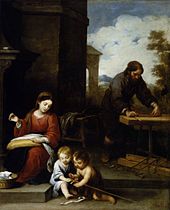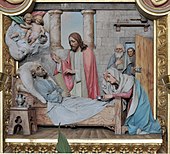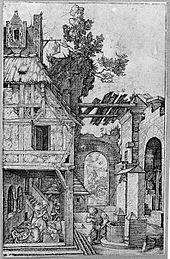Saint Joseph
Joseph (Hebrew יוֹסֵף, Greek Ἰωσήφ) of Nazareth or Joseph of Nazareth is the bridegroom of Mary, the mother of Jesus, in the New Testament. The Gospels and the Protoevangelium of James report that he was a carpenter or builder from Nazareth, hence he is also called "the carpenter" in Christian tradition.
In the New Testament John says that Joseph was the father of Jesus according to the people (Joh 1,45 EU: "Jesus from Nazareth, the son of Joseph"). Furthermore siblings of Jesus are mentioned, among them James. That Joseph was also their father, however, is not explicitly mentioned (Mt 13,55 EU and Mk 6,3 EU). The Evangelists Matthew (Mt 1,18 EU) and Luke (Lk 1,35 EU), on the other hand, emphasize that Joseph was only the legal father of Jesus, since Mary did not conceive him through human procreation, but through the action of the Holy Spirit. This is followed by the church doctrine of the virgin birth. Especially in Catholic literature Joseph is often called the foster father (Latin nutritius) or foster father of Jesus.

Bartolomé Esteban Murillo, The Holy Family with the Infant John (between 1655 and 1660): in the background Joseph as a craftsman

Guido Reni, Joseph of Nazareth (1640)

Caspar Jele, St. Joseph with the infant Jesus (1848): Joseph with lily
Worship
In the Eastern Church, St Joseph was venerated very early, but in the Western Church only from about 850 onwards, and only very hesitantly, since the legal relationship of paternity was considered difficult to understand in the Middle Ages; a theological profiling of his personality as the father of Christ as well as the husband of Mary and defender of her virginity (Defensor virginitatis) began in the 15th century with Gerson, d'Ailly and Bernardine of Siena. Since the 17th century, St. Joseph, who according to tradition died in the womb of Mary and in the presence of Jesus, became the patron saint of the dying; his veneration as a refuge for the dying (Refugium agonizantum) was promoted by the Carmelites and especially by the Jesuits.
Pope Pius IX declared St. Joseph the patron saint of the Catholic Church in 1870. Pope Leo XIII, in his encyclical Quamquam pluries of August 15, 1889, emphatically acknowledged the outstanding devotion to St. Joseph. The life of St. Joseph and the encyclical were honored on the 100th anniversary on August 15, 1989, by Pope John Paul II in the apostolic exhortation Redemptoris custos. In the 20th century, more Catholic churches were dedicated to St. Joseph than to any other saint (excluding patronages of the Blessed Mother). Certain ecclesiastical buildings are called Josefinum after his patronage. Since 1679, St. Joseph has been the patron saint of the Spanish Netherlands and is the patron saint of Belgium and the Croats.
In 1955, Pius XII introduced the commemoration of St. Joseph the Worker as an ecclesiastical counterpart to Labour Day, which is celebrated worldwide on 1 May. In biblical tradition, St. Joseph worked as a building craftsman and is thus traditionally considered the patron saint of workers, especially carpenters and woodcutters. He is also considered the patron saint of virgins and married couples. The insertion of the day of remembrance into the liturgical calendar was a reaction of the church to the social movement.
Pope John XXIII designated Saint Joseph, along with Mary, the Mother of God, as the special patron saint of the SecondVatican Council, and his invocation was inserted into the high prayer, the Canon Missae. With the decree of the Congregation for Divine Worship and the Discipline of the Sacraments of 1 May 2013, the mention of Saint Joseph was also decreed for High Prayers II to IV.
Pope Francis proclaimed a "Year of St. Joseph" on December 8, 2020, 150 years after Pius IX proclaimed St. Joseph the patron saint of the Church, and published the Apostolic Exhortation Patris corde. Into the Litany of St. Joseph, Pope Francis ordered seven new invocations on 1. On 1 May 2021, Pope Francis added seven new invocations to the Litany of St. Joseph: "Custos Redemptoris" (Guardian of the Redeemer), "Serve Christi" (Servant of Christ), "Minister salutis" (Servant of Salvation), "Fulcimen in difficultatibus" (Helper in Difficulties), "Patrone exsulum" (Patron of the Exiled), "Patrone afflictorum" (Patron of the Afflicted) and "Patrone pauperum" (Patron of the Poor).
_14.jpg)
The death of St. Joseph, chiesa San Carlo Borromeo in San Marzano di San Giuseppe

The Death of St. Joseph, wood carving from Val Gardena (Albino Pitscheider, around 1910)

St. Joseph with Jesus, Bulgarian icon (around 1850)

Albrecht Dürer, The Weyhnachten (1504): Joseph fetches water
Iconography
Iconographic attributes of the saint are the walking stick - occasionally as a flowering stick -, the square measure or other tools for his profession as a carpenter. In addition, the white lily or, in Latin America, the tuberose (e.g. in the coat of arms of Pope Francis) is used as a symbol of chastity or purity. In the depiction of Joseph as a sleeping man, reference is made to the dreams he had, according to the Gospel of Matthew, in which he received divine instruction to flee to Egypt and return to Israel. Until the 15th century he was depicted as a young man without a beard, later usually as a bearded older man. His clothing was often middle-class.
Images of St Joseph can be found in many churches and monasteries. In paintings of late medieval art until the end of the 19th century, Joseph was not depicted as a single significant personality, but almost exclusively in scenes relating to the life of Jesus, the life of Mary or in the context of the Holy Family. He is often typecast as a caring family man: Joseph cares for the child, washes, fetches water, builds a fire and cooks.
In Baroque iconography, the death of St Joseph becomes a popular theme in connection with his veneration as the patron saint of the dying. In some depictions, the dying Joseph rests in Mary's lap, and Jesus holds his hand. John the Evangelist or an angel holding Joseph's flowering staff may also be present.
Search within the encyclopedia